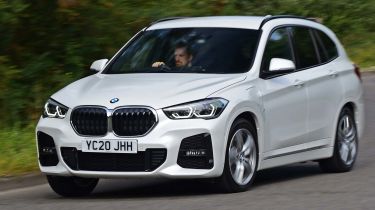BMW X1 hybrid (2019-2022) review
The BMW X1 xDrive25e is a plug-in hybrid SUV that's faster and more refined than its non-electrified siblings

Pros
- Refined cruiser
- Great performance
- Best-in-class rear space
Cons
- Some rivals offer more standard kit
- Weight affects handling slightly
- Expensive for private buyers
| Car type | Electric range | Fuel economy | CO2 emissions |
|---|---|---|---|
| Plug-in hybrid | 30-32 miles | 149-157mpg | 40-44g/km |
SUVs are all the rage, with premium plug-in hybrid models in particular appealing to a surprisingly broad range of buyers. The BMW X1 xDrive25e is one such model that's likely to appeal to fans of the badge, company-car drivers and anyone seeking a hybrid who enjoys a model with precise handling. That's because the X1 is a bit more fun to drive than the Volvo XC40 Recharge T4, Mercedes GLA 250 e or Jaguar E-Pace P300e, while sharing quite a few parts with the MINI Countryman Cooper S E ALL4.
The X1 xDrive25e is fitted with a 1.5-litre, three-cylinder petrol engine, an electric motor and a battery pack. Once charged at home or at a public charger, this setup can provide reduced emissions and improved fuel-efficiency, with the option of zero-emissions driving for short trips. It's a setup shared with the more low-slung X2 xDrive25e sister model, which is more expensive to buy, yet also less practical.
The X1 plug-in hybrid has a total power output of 220bhp from a 123bhp petrol engine and 94bhp electric motor. The powertrain offers strong performance and makes the SUV feel much more sprightly than its petrol or diesel-powered counterparts. Handling-wise, the X1 is more fun to drive than its XC40 rival and feels composed through corners.
The addition of a 10kWh battery and that motor have resulted in a bit of a weight gain, but BMW has done a good job of keeping it under control. Plus, in ‘MAX eDrive’ mode, the X1 xDrive25e is capable of up between 30 and 32 miles of pure-electric driving. We saw a figure closer to 25 miles when we tested it, but that's still competitive.
Inside, the X1 is relatively unchanged from the petrol and diesel versions, albeit with some encroachment (around 55 litres) from the batteries on boot space. There's plenty of space front and rear for adult passengers to get comfortable, with those in the back treated to class-leading head and legroom.
Up front, the dashboard hosts one of the best infotainment systems on the market, but getting all of the standard equipment you might want – including active safety systems like adaptive cruise control – requires opting for some of BMW’s four-figure option packs available on the X1.
But the X1 isn’t exactly the cheapest small SUV around to begin with, as prices for the M Sport model start at over £40,000. In xDrive25e plug-in hybrid form, prices are around £2,000 more than the equivalent petrol model. That may be a tough pill for private buyers to swallow, but company-car drivers will be pleased by the fact that in plug-in hybrid form, the X1 only attracts a 12% Benefit-in-Kind company-car tax rate. For reference, the entry-level diesel X1 falls in the 31% band.
However, if you're a private buyer and most of your journeys are shorter, then the X1 could save you money on fuel bills in the longer term. Plus, the X1 remains the more fun to drive option in this crowded segment of electrified vehicles.
This X1 is being replaced by an all-new model later in 2022. The next generation promises even lower running costs, with the addition of a fully electric iX1 for the first time. There’ll also be not one, but two plug-in hybrid models if you’d like to switch between petrol and electric power, the latter with a much punchier output.
Read the rest of our review for a more in-depth look at the BMW X1 xDrive25e and how it compares to its nearest rivals...
